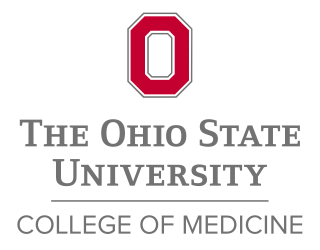
The Ohio State University, commonly called Ohio State or OSU, is a public land-grant research university in Columbus, Ohio. A member of the University System of Ohio, it has been ranked by major institutional rankings among the best public universities in the United States. Founded in 1870 as the state's land-grant university and the ninth university in Ohio with the Morrill Act of 1862, Ohio State was originally known as the Ohio Agricultural and Mechanical College and focused on various agricultural and mechanical disciplines but it developed into a comprehensive university under the direction of then-Governor and later U.S. president Rutherford B. Hayes, and in 1878 the Ohio General Assembly passed a law changing the name to "the Ohio State University" and broadening the scope of the university. Admission standards tightened and became greatly more selective throughout the 2000s and 2010s.

The University of California, San Francisco (UCSF) is a public land-grant research university in San Francisco, California. It is part of the University of California system and is dedicated entirely to health science. It conducts research and teaching in medical and biological sciences.

Antioch University is a private university with multiple campuses in the United States and online programs. Founded in 1852 as Antioch College, its first president was politician, abolitionist, and education reformer Horace Mann. It changed its name to Antioch University in 1977 to reflect its growth across the country into numerous graduate education programs. It now operates four campuses located in three states, as well as an online division and the Graduate School of Leadership and Change. All campuses of the university are regionally accredited by the Higher Learning Commission. Campuses are located in Los Angeles, California; Santa Barbara, California; Keene, New Hampshire; and, Seattle, Washington. Additionally, Antioch University houses two institution-wide programs, the Graduate School of Leadership and Change and Antioch University Online. Antioch University suspended operations of Antioch College in 2008, and later sold the campus and a license to use the name "Antioch College" to a new and independent non-profit corporation in 2009. Since then, the college has had no affiliation with the university.

Albert Einstein College of Medicine is a research-intensive medical school located in the Morris Park neighborhood of the Bronx in New York City. Founded in 1953, Einstein operates as an independent degree-granting institution as part of the integrated health care system, Montefiore Health System, which includes affiliates such as Jacobi Medical Center.

Baylor College of Medicine (BCM) is a private, independent health sciences center in Houston, Texas within the Texas Medical Center, the world's largest medical center. BCM is composed of four academic components: the School of Medicine, the Graduate School of Biomedical Sciences; the School of Health Professions, and the National School of Tropical Medicine.

Oklahoma State University Center for Health Sciences (OSU-CHS) is a public medical school in Tulsa, Oklahoma. It also has a branch campus in Tahlequah, Oklahoma. Founded in 1972, OSU-CHS is part of the Oklahoma State University System. OSU-CHS offers a Doctor of Osteopathic Medicine (D.O.) and over fifteen other different graduate degrees.
The Medical Scientist Training Programs (MSTPs) are dual-degree training programs that streamline the education towards both clinical and research doctoral degrees. MSTPs are offered by some United States medical schools, who are awarded financial support from the National Institute of General Medical Sciences (NIGMS), a branch of the National Institutes of Health (NIH). The goal of these training programs is to produce physician scientists who can translate laboratory discoveries into effective treatments for patients.
Altaf A. Wani, Ph.D. is retired a professor in the Department of Radiology and the Department of Cellular and Molecular Biology at Ohio State University (OSU). He eas a member of Molecular Carcinogenesis and Chemoprevention program of the James Cancer Hospital and Research Institute. Dr. Wani was the Director of Molecular Carcinogenesis Laboratory and conducts Basic Cancer research in the area of DNA damage and repair.

The Ohio State University College of Medicine is the medical school at The Ohio State University and is located in Columbus, Ohio. The college is nationally recognized as a top institution in both education and research, as reflected by rankings in U.S. News & World Report. In 2009, its two primary teaching hospital were ranked as one of the best hospitals in the U.S. in 10 different specialties; and named to U.S. News & World Report's select honor roll of U.S. hospitals.

Leonard M. Miller School of Medicine (UMMSM) is the University of Miami's graduate medical school in Miami, Florida. Founded in 1952, it is the oldest medical school in the state of Florida.
The University of Illinois College of Medicine offers a four-year program leading to the MD degree at four different sites in Illinois: Chicago, Peoria, Rockford, and formerly Urbana–Champaign. The Urbana–Champaign site stopped accepting new students after Fall 2016 to make room for the newly established Carle Illinois College of Medicine.

The University of Nebraska Medical Center (UNMC) is a public academic health science center in Omaha, Nebraska. Founded in 1869 and chartered as a private medical college in 1881, UNMC became part of the University of Nebraska System in 1902. Rapidly expanding in the early 20th century, the university founded a hospital, dental college, pharmacy college, college of nursing, and college of medicine. It later added colleges of public health and allied health professions. One of Omaha's top employers, UNMC has an annual budget of $841.6 million for 2020 to 2021, and an economic impact of $4.8 billion.
The University of Cincinnati Academic Health Center (AHC) is a collection of health colleges and institutions of the University of Cincinnati, Cincinnati, Ohio. It trains health care professionals and provides research and patient care. AHC has strong ties to UC Health, which includes the University of Cincinnati Medical Center and West Chester Hospital.

Georgetown University School of Medicine, a medical school opened in 1851, is one of Georgetown University's five graduate schools. It is located on Reservoir Road in the Georgetown neighborhood of Washington, DC, adjacent to the University's main campus. The School of Medicine works in association with the 609-bed MedStar Georgetown University Hospital, MedStar Washington Hospital Center, and nine other affiliated federal and community hospitals in the Washington metropolitan area. Georgetown is the oldest Catholic medical school in the United States.

The John Glenn College of Public Affairs is a public policy and management school at Ohio State University. The Glenn College offers undergraduate, graduate and doctoral programs in public affairs. The Glenn College provides research, training and technical assistance to state, public and nonprofit organizations. The college is named after United States Senator and Astronaut John Glenn. On January 30, 2015, the Ohio State University Board of Trustees approved a change of status of the former John Glenn School of Public Affairs making the new John Glenn College of Public Affairs the 15th college at The Ohio State University.
Diana Chapman Walsh was President of Wellesley College from 1993 to 2007. During her tenure, the college revised its curriculum and expanded its programs in global education, internships and service learning, and interdisciplinary teaching and learning. The faculty established new majors in environmental studies, quantitative reasoning, cinema and media studies, neurosciences, and astrophysics. Japanese, Arabic and Korean languages were added to the curriculum as well, and a new department of East Asian Languages and Literatures was launched.

Prior Hall, originally known as the Health Sciences Library, is the home of the medical library at Ohio State University. The library was named the John A. Prior Health Sciences Library in 1988 and later renamed to Health Sciences Library in Prior Hall.

Ruth Lillian Kirschstein was an American pathologist and science administrator at the National Institutes of Health (NIH). Kirschstein served as director of the National Institute of General Medical Sciences, deputy director of NIH in the 1990s, and acting director of the NIH in 1993 and 2000-2002.
The Case Western Reserve University Department of Biomedical Engineering launched in 1968 as one of the first Biomedical Engineering programs in the world. Formally incorporated in both the School of Engineering and School of Medicine, the department provides full research and education programs and is consistently top-ranked for graduate and undergraduate studies, according to U.S. News & World Report.
Barbara Ross-Lee, D.O. is an American physician, academic, and the first African-American woman to serve as dean of a U.S. medical school; she is also known as the sister of global music sensation Diana Ross along with being the aunt of actress Tracee Ellis Ross, and singer-songwriters Rhonda Ross Kendrick and Evan Ross. She majored in biology and chemistry at Wayne State University, graduating in 1965. Then, in 1969, she entered Michigan State University's College of Osteopathic Medicine. Ross-Lee then went on to open her own private family practice, teach as a professor, and hold other positions within the medical community. In 1993, she was elected as the first woman dean of a medical school, at Ohio University's Heritage College of Osteopathic Medicine. She has earned several awards and honors for her work and accomplishments.













